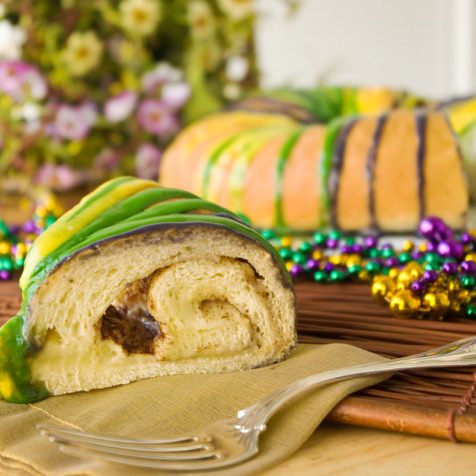King Cake

Description
Mardi Gras/Carnival season officially began on January 6th or the “Twelfth Night,” also known to Christians as the “Epiphany,” and culminates on Tuesday, March 1st – a day affectionately known as “Fat Tuesday”. While there are many traditional Mardi Gras dishes to enjoy during this time of feasting and revelry leading up to Lent, none is quite so ubiquitous as the king cake. The rich history of the king cake dates all the way back to the Middle Ages with the first known king cakes baked in Europe in celebration of the Catholic Epiphany, also known as Three Kings Day on January 6th. The French brought the cake with them to the Gulf Coast region of the United States in the 1870s, and it has since become synonymous with American celebrations of Mardi Gras. The first Mardi Gras celebration in America took place in 1703, when a group of French soldiers held an impromptu celebration in the settlement of Mobile, Alabama. While there are many regional variations, Mardi Gras king cakes found in most American bakeries are traditionally crown-shaped brioche-style confections decorated in royal colors of purple, green, and gold representing justice, faith, and power, respectively. They also typically contain a token of good fortune hidden within the cake, bestowing the recipient with luck and prosperity and the responsibility of providing the king cake for the next year’s festivities. This token is often represented as a bean, pea, or plastic baby. You’ll find many of the ingredients needed to prepare your own Mardi Gras king cake in our weekly sale from February 24th – March 2nd, so it’s a perfect time to give this traditional treat a try!
Instructions
Lightly grease a baking sheet, or line it with parchment.
To prepare the dough: Using a stand mixer, electric hand mixer, or bread machine, mix and knead all of the dough ingredients together to form a smooth, very silky dough. You may try kneading this dough with your hands, if desired; but be advised it’s very sticky and soft. Allow the dough to rise, covered, for 1 hour. It’ll become puffy, though it probably won’t double in size. Transfer the soft dough to a lightly greased work surface. Pat and stretch it into a 24″ x 6″ rectangle. This won’t be hard at all; it’s very stretchy. Let the dough rest while you prepare the filling.
To prepare the filling: Beat together the cream cheese, sugar, and flour until smooth, scraping the bowl once. Add the egg, cinnamon, and vanilla, again beating until smooth. Dollop the filling down the center of the long strip of dough and sprinkle the pecans over top. Then fold each edge up and over the filling until they meet at the top; roll and pinch the edges together, to seal the filling inside as much as possible. Place the log of dough onto the baking sheet seam-side down. The dough will stretch as you handle it, so pick it up and position it on the pan quickly and gently. Pinch the ends together. Cover and let rise for about an hour, until it’s puffy. Preheat the oven to 350°F while the dough rises. Whisk the reserved egg white with 1 tablespoon water, and brush it over the risen cake. Bake the cake for 20 minutes, then tent it lightly with aluminum foil. Bake it for an additional 30 minutes, until it’s a rich golden brown. Remove the cake from the oven. After about 15 minutes, transfer it from the baking sheet to a rack to cool.
To make the icing: Beat together all of the icing ingredients, dribbling in the final 2 teaspoons of milk until the icing is thick yet pourable. Portion into three equal-sized bowls and add a few drops of purple, green, and gold food coloring to each bowl. Pour each bowl of colored icing over a section of the completely cooled cake until the whole cake is covered.



